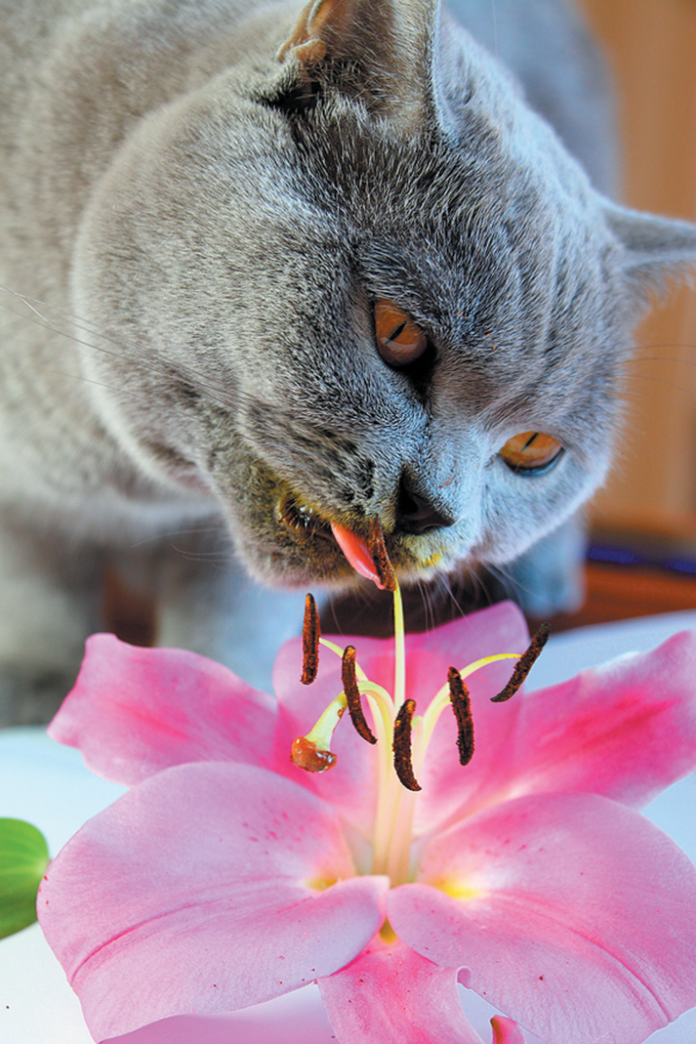On average, a cat is brought to the emergency room at Tufts’s Foster Hospital for Small Animals at least every other day as a result of having swallowed something poisonous. So reports Tufts emergency and critical care veterinarian and Catnip editorial advisory board member Elizabeth Rozanski, DVM. “Some days,” Dr. Rozanski says, “we’ll treat three poisoned cats in a single day.”
Toxicities are certainly much more common than many of the other reasons cats are rushed in. People know something’s wrong. The cat has started drooling, or vomiting, or walking unsteadily or even having respiratory difficulties. Often there’s attendant sluggishness.
But what might a cat have swallowed that she shouldn’t have? The ASPCA’s list of poisonous plants alone is dizzying, with literally dozens upon dozens of potential culprits that can make a feline ill. And that doesn’t even get to household products like carpet fresheners and fabric softener sheets or human medications including Adderall and aspirin. Or breath fresheners and bar soap. Or gardening chemicals, onions and garlic, alcohol, paint thinner, and so on.
How are you supposed to keep your cat safe from the many things in your home that could seriously harm her — or worse — if ingested? By all means check the feline poison lists on the ASPCA’s website, but Dr. Rozanski says three substances are responsible for the majority of poisonings diagnosed and treated at Tufts.
Topical anti-flea products containing permethrin. Last month we said that every cat should be on a flea preventative all year long. And we said that the most popular mode of delivery into a cat’s system is via a topical, or spot-on. It’s generally applied every 30 days with a pipette between the shoulder blades, and from there it sinks into the skin.
However, in concentrations that are too high, the active ingredient in these products, permethrin, can cause problems including very severe tremors and even death. You won’t apply too much if you use a product specifically meant for cats. The problem arises because some people mistakenly apply the anti-flea medicine meant for a dog to a cat. It’s the same medicine, but with much more permethrin. Don’t make that error; read labels carefully to make sure the medicine you intend to give your cat is meant for cats.
Also, if you have a dog and apply the medicine between his shoulder blades, don’t let your cat near him for 24 hours; your feline pet can lick up the topical before it is fully absorbed.
Acetaminophen. The generic name for Tylenol, acetaminophen swallowed by a cat can cause severe liver damage in addition to interfering with the capacity of red blood cells to carry oxygen to all the body’s tissues. There are a couple of ways cats are poisoned by this over-the-counter medicine, Dr. Rozanski says. Either an owner accidentally drops a pill on the floor and the cat comes along and eats it. Or the owner thinks baby Tylenol is a good way to relieve a cat’s pain. It’s not. “Even a tiny amount of acetaminophen can be toxic to a cat,” Dr. Rozanski says.
Lilies. Easter’s coming next month, and so are the lilies. But lilies are seriously dangerous for a cat to ingest — even just a little bit. In fact, if you have lilies in the house and notice your cat suddenly seeming seriously ill, get her to the emergency room immediately. Her kidneys could stop producing urine, and if they do, she may die. With lily ingestion, you have zero time to lose. Even then, your cat will probably be in the hospital for a couple of days on an IV drip.
It’s not just Easter lilies that are so dangerous, by the way. Lilies of any kind must be off limits to cats: tiger lilies, stargazer lilies, and so on.





Widgit our 7 yr had an enema with vet sat, today day 5 no poop !! shud we be very worried
pkease help or suggest. She is on Mirulax 2 times a day also Lactulose also twice a day not working
I’m not a veterinary professional, but I had a senior cat who was not having regular bowel movements, sometimes going 4 or 5 days without an event. I started adding Missing Link Feline nutritional supplement to her canned food meals. Just tiny amounts at first, until we worked up to most of the recommended dose after a few days. This worked extremely well for her. Her bowels moved daily or every other day, and her coat improved significantly.